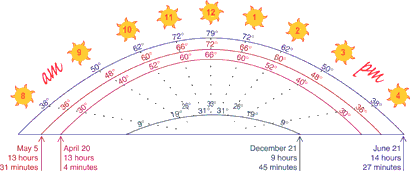|
We’re looking at the question, "why are the days getting longer?"
Remember! This is a reprint of an article that originally appeared in the LA Times on May 20, 1999. That means the days were getting longer as summer approached. Now summer is over and winter is approaching. Have you noticed how the length of day has been changing?
We have been exploring the relationship between the Sun and the Earth and how it affects the length of the day. Many of you have
used your celestial sphere to track the movement of the Sun across the sky. (For instructions on how to build your own sphere, go
to the Sun Spot at whyville.net).
In order to answer the question "Why are the days getting longer?", I asked you to build a celestial sphere and measure the
height of the Sun at different times during the day (instructions are at the Sun Spot in whyville.net). Those of you that keep on measuring the Sun's movement will see that it is even higher this week, and also that the days keep getting longer. So it seems that the higher the Sun gets, the longer its track across the sky, and the longer the day.

Last week, we saw that the Sun was higher in the sky on May 5th than it had been on April 20th, and the day was 27 minutes longer. But the days don't keep getting longer forever (at least they never have before!). So the question is, when will the days start getting shorter again? We have plotted several Sun tracks on our graph that help answer that. The red tracks are those we made over the last month. The blue ones represent the longest and shortest tracks we can expect in the next year in Los Angeles. I got this future data from looking at the sun tracker simulation in Whyville, or you can get it from the Griffith Observatory (www.griffithobs.org). The Sun will be its highest (and the day the longest) on June 21st, and the Sun will be the lowest (and the day the shortest) on December 21st. These days are known as the summer and winter solstices.
 |
Here's a final question for this week by Jennifer Hashem, who wrote in and asked, "Why is the Earth sometimes hot and sometimes cold?" What we can see from our graph is that when the Sun is highest in the sky, the days are longer (and days are shorter when the Sun is lower in the sky). So, I'll bet that how warm it gets has something to do with the amount of energy we get from the Sun during those long days. But here in Los Angeles, if the Sun is highest every June 21st, what else is going on that makes August the hottest month of the year? Any ideas? Let me know by posting your thoughts at the Sun Spot Bulletin Boards.
|
Next week, we will consider what the sun is doing in other spots on the Earth. So have your distant friends and relatives do their experiments, too. Remember, we need everyone's data next week. See you then!
|